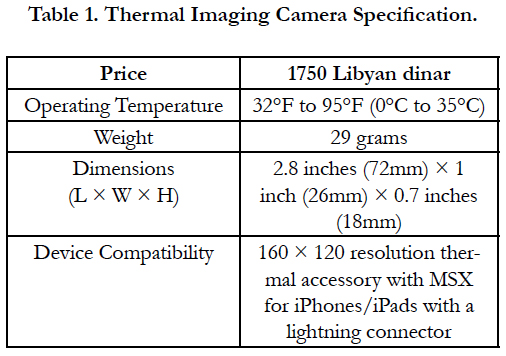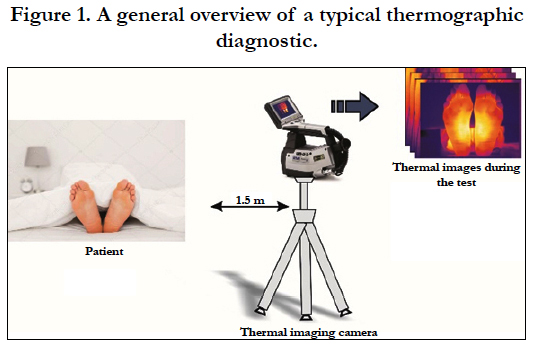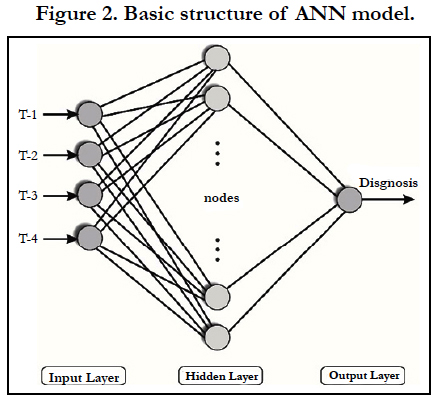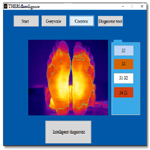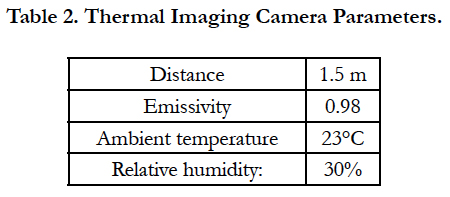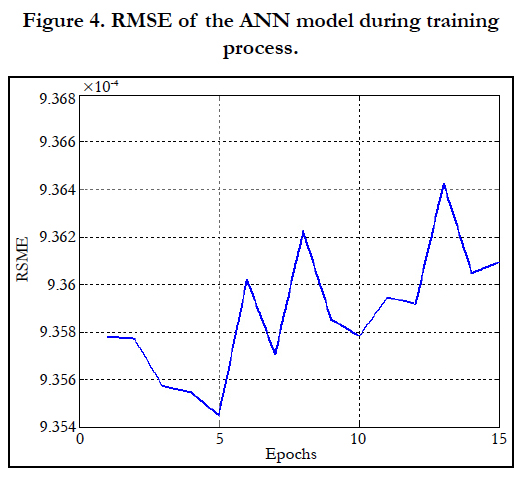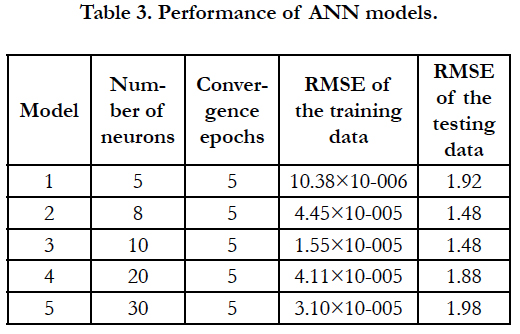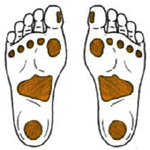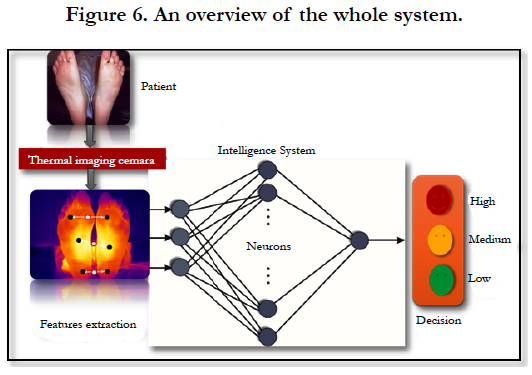Early Detection of Diabetes using Thermography and Artificial Neural Networks
Abdulshahed AM1*, Alabyad FM2, Goohe HA2, Saed MA2
1 Electrical and Electronic Engineering Department, Misurata University, Libya.
2 College of Technical Sciences Misurata, Libya.
*Corresponding Author
Ali M Abdulshahed,
Electrical and Electronic Engineering Department,
Misurata University, Libya.
E-mail: aa_shahed@yahoo.com
Received: June 26, 2017; Accepted: Septamber 05, 2017; Published: September 25, 2017
Citation:Abdulshahed AM, Alabyad FM, Goohe HA, Saed MA. Early Detection of Diabetes using Thermography and Artificial Neural Networks. Int J Comput Neural Eng. 2017;4(2):71-75. doi: dx.doi.org/10.19070/2572-7389-170009
Copyright: Abdulshahed AM© 2017. This is an open-access article distributed under the terms of the Creative Commons Attribution License, which permits unrestricted use, distribution and reproduction in any medium, provided the original author and source are credited.
Abstract
The aim of this work is to demonstrate the usefulness of the artificial intelligence tools for early detection of diseases. From the historic and simple assessment of temperature by the clinical thermometer, thermal imaging camera has opened up new perspectives, and that a whole image field-of-view can be characterized in a single measurement. Thermographic assessment of temperature distribution within the examined skin enables a quick, non-contact, non-invasive relative measurement of their temperature. No literature has been found until date detection of diabetes using thermography and artificial neural networks. An attempt in this regard could help doctors make a safer decision. This work shows that the output predicted using the artificial neural network based on thermography, can be used for early detection of diabetes.
2.Introduction
3.Material And Methods
3.1.Thermal Imaging Camera
3.2.Artificial Intelligence (AI) model
4.Results And Discussion
4.1.Case Study
5.Conclusion
6.Acknowledgement
7. References
Keywords
Thermal Imaging Camera; Artificial Neural Networks (ANN); Diabetes.
Introduction
According to the World Health Organization, in 2009, approximately 347 million were infected with the diabetes, and it is expected that in 2030 the number will reach about 500 million [1]. Libya is one of the North Africa countries, and according to the International Diabetes Federation estimates, the prevalence of diabetes among adults in Libya is 10.4% [2]. Foot ulcers are a common complication of poorly controlled diabetes, forming as a result of skin tissue breaking down and exposing the layers underneath. Early diagnosis of diabetic foot complications and their precursors is essential in preventing their signs consequences, such as foot infection and amputation. Abnormal skin temperature is a natural indicator of illness [3]. The human skin temperature distribution of a healthy body exhibits a contralateral symmetry [4]. From the traditional assessment of temperature by the thermometer, modern thermal imaging camera technology has opened up new perspectives, especially in the use of thermography to map a body temperature with a remote-sensing camera. Thermography is a reliable non-invasive technique for imaging skin temperature distribution. It is a remote and a non-contact temperature measuring technique that enables simultaneous monitoring a large area of the human skin surface. Infrared thermal imaging, unlike many other imaging techniques used in medicine, is not an internal imaging system for anatomical information. The human skin surface is a highly efficient radiator, with an emissivity of 0.98 [5]. This technology has the benefits of no material placed on a human skin surface, and that a whole image field-of-view can be characterized in a single measurement. Several applications of thermography in medical science has been highlighted in B Lahiri, et al., (2012) [3]. Thermography has been extensively used for diabetic neuropathy, breast cancer detection, fever screening, brain imaging and assessment of radiation damage to human body [3]. Bagavathiappan et al., [6] used the thermal imaging camera to study the plantar foot temperatures of 112 patient subjects with type 2 diabetes selected from a tertiary diabetes center in South India. They indicated that thermography can be used as an additional tool for evaluation of high risk diabetic feet. However, assessing thermal images is a complex and subjective task that can be greatly facilitated by artificial intelligence techniques.
Most of medical imaging procedures have benefited from the use of modern artificial intelligence systems [7]. An artificial intelligence system is a system that can make decisions which would be considered intelligent if made by a human being. Artificial Intelligence (AI) is becoming more popular and particularly amenable to modelling complex systems, because it has demonstrated superior predictive ability compared to traditional methods. To find the relationship between inputs and outputs of a complex system, artificial neural network (ANN) techniques have drawn more attention rather than statistical models, and produce results without requiring a detailed description of the phenomena that is governing the system. There are different ANN architectures to building thermal models, Back-Propagation (BP) artificial neural network modelling has proven to be a suitable nonlinear modelling method.
In the past, the model had to be kept as simple as possible. For instance, although the ANN models are more accurate than the regression models, the calibration of the regression model’s coefficients is simpler (least squares approach) [8]. However, the use of mathematical software tool such as that existing in MATLAB facilitates the calibration of the model coefficients by using optimization/training tools [9]. Nevertheless, there is still a strong argument for simplicity, where possible, to avoid overconstraining the system and introducing instability.
Human skin temperature, the information that can be investigated by the thermograph, is dependent on blood circulation. In ischemic conditions, where blood perfusion may be reduced, especially at the periphery of the human body and limbs (hands and feet), reduced temperature may be found. This requires a period of stabilization, where the patient is resting in the stable room temperature) for a period of time prior to examination. During this time, areas of the body to be examined must be unclothed [5].
Medical thermography is used as a screening method for early detection of cancer and diabetes [10], but the use of this technology in Libya has still not been researched. This work presents a technique for early diagnostic of diabetes using thermal imaging camera and artificial neural networks, in order to facilitate the physician's decision making. First, the thermal images are pre-processed to reduce the noise introduced during the initial acquisition. Then, potential regions of interest are identified using imaging process tools such as isothermal analysis and segmentation techniques. Finally, the proposed ANN model was used to predict the patient status.
A thermal imaging camera provides a visible image of otherwise invisible infrared light that is emitted by all bodies due to their thermal status. Thermography is a reliable non-invasive technique for imaging skin temperature distribution. The thermal imaging camera has become a powerful tool for researchers and has applications in various fields such as medicine, biometrics, computer vision, building maintenance and so on [11, 12]. In this paper, a medium-specification thermal imaging camera, namely an FLIR ONE™, was used to record a sequence of thermal images of temperature distributions across the patient foot. This camera provides a sensitivity of 0.1 °C, and a scene temperature range -20°C - 120°C. Full camera specifications are provided in Table 1. The thermal imaging camera offers a continuous picture of the temperature distribution in the image field-of-view. This is important as it provides the distribution of heat during the diagnostic period across the whole patient body. This allows the patient skin to be measured online during the diagnostic period. As well as the camera providing live continuous thermal images, they can also be recorded for further analysis. The thermal images are saved as a matrix of temperatures with a specific resolution of one pixel (equivalent to 5.50 mm2), which equates to over 38000 temperature measurement points for this 160 x 120 resolution camera. These thermal images can be transferred to a personal computer for analysis. Figure 1 shows a general overview of the diagnostic setup.
Artificial neural network as a form of AI is a data-driven approach. It is designed in a way that mimics the behavior of biological neural network. A typical artificial neural network has an input layer, one or more hidden layers, and an output layer [13]. The neurons in the hidden layer, which are connected to the neurons in the input and output layers by adaptable weights, enable the ANN to compute complex associations between the input and output variables [14]. The inputs of each neuron in the hidden and output layers are summed, and the resulting summation is processed by an activation function [14]. Training the model is the process of determining the adjustable weights, and it is similar to the process of determining the coefficients of a regression model by least squares approach. The weights are initially selected randomly and an optimization algorithm is then used to find the weights that minimize the differences between the modelcalculated and the experimental outputs [15]. Across the whole modelling procedure, no physical equation is used (see Figure 2).
Results And Discussion
In this paper, the data has been analyzed using MATLAB. One disadvantage of thermal imaging is that it can have low absolute accuracy, usually in the order of ±2 ºC. A number of MATLAB functions have been developed to enhance this accuracy, including averaging the images to reduce pixel noise, alignment of images and extraction from the temperature data by averaging groups of pixels at a specific point (see Figure 3).
The radiation measured by the thermal camera depends on the temperature of the body, but is also affected by the emissivity of the body skin. Additionally, radiation reflects from shiny surfaces, and is directly captured by the thermal camera and appearing as very hot areas. In order to measure the temperature of the body precisely it is therefore, necessary to know the emissivity accurately, for which the application of masking tape with a known emissivity (0.95) is a common and effective solution. The camera parameters are then set according to the measurement conditions considering the emissivity of the skin human body, the distance between the body and the camera, the relative humidity and the ambient temperature, as illustrated in Table 2.
In order to illustrate the application of the model in automated detection of diabetic foot, we used simple case study and calculate the model. The model is conducted on realistic data from 90 patients. Due to low accuracy of our FLIR ONE™ camera, 85 exams were performed from 1 February to 30 June 2013 in the Dos de Mayo hospital [1], and 5 exams were performed in the Misurata hospital. In order to optimize the ANN coefficients, the exam’s dataset was divided into two sets, one is being used for training the model (approximately 60 %), and the rest for testing performance (approximately 40 %). Four temperature spots are used as inputs, and a patient’s status as output.
Usually ANN models have three layers: Input, hidden and output layer. Although, for common engineering problems, one hidden layer is sufficient for model training [16, 17], two or more hidden layers may be needed for other applications [18]. An ANN model with three layers was used in this paper: the input layer has 4 input variables and the output layer has one neuron (the diagnosis).
Selection of the number of neurons in the hidden layer is important for finding a suitable ANN model structure. Although increasing the neuron numbers in the hidden layer, may help to improve the neural network performance, however, the possibility of over-fitting may increase. Furthermore, a large number of hidden neurons can increase model training time. In this paper, different ANN models were evaluated using Root-Mean-Square Error (RMSE), in order to measure the deviation between the training data and predicted values. In Figure 4 the RMSE of ANN model for the training data is plotted versus the epochs. It is observed that after 5 epochs were used, the performance does not improve any further. Before generating the final model, it is essential to obtain the optimum number of neurons in the hidden layer. For this purpose, several ANN models can be constructed with a different number of neurons. The optimum size of the model structure was determined, and the results are summarized in Table 3. It was found that the ANN model with 10 neurons exhibited the lowest error RMSE=1.48 for testing dataset.
There are areas where it is very likely that a foot ulcer occurs as shown in Figure 5. Detecting problems in these areas is of great interest. It should be noticed that temperature of corresponding area of the right and left foot do not usually differs more than 1°C. However, a temperature difference greater than 2.2°C is considered as a sign of a possible foot ulcer [1, 19]. Extracting this increased temperature between the right and left foot is important for the accuracy of the ANN model.
Figure 5. Areas at risk on the foot [19].
The results of this study strongly suggest that recent improvements in thermography techniques and artificial intelligence tools have indeed contributed to increased performance when using such a system for early detection of some diseases such as diabetes and cancer. These early results using the proposed system are promising and further studies should be carried in this regard. Figure 6 illustrate an overview of the whole system.
To obtain robust detection model, long term experimental data is required. However, the size of the input-output dataset is very crucial when the generation of data iscostly affair (several clinical examination). For instance, the process of obtaining such data can take several months for normal condition exams and for a year or more for abnormal exams. One way to overcome this problem, the physician needs to borrow a valid white-box model to supplement the experimental data.
Conclusion
In this contribution, we successfully used an ANN model and thermal imaging camera for early diagnosis of diabetic foot. As a result of the proposed method, the initial model can be sufficiently well defined to the point that it might only need a small number of training iterations. We believe that correlation between foot temperature change and diabetes as described in this paper deserves further analysis in Libya, in order to create a new tool for early detection of diabetes and other diseases.
Acknowledgment
The authors would like to acknowledge the Misurata University, and College of Technical Sciences for giving permission for publication.
References
- LV Cajacuri. Early diagnostic of diabetic foot using thermal images. université d'orléans. 2013.
- D Gan. International Diabetes Federation. 2nd ed. Diabetes Atlas. 2017.
- B Lahiri, Bagavathiappan S, Jayakumar T, Philip J. Medical applications of infrared thermography: a review. Infra Phys Technol. 2012 Jul;55(4):221- 235.
- Y Houdas, E Ring. Human body temperature: its measurement and regulation. 1st ed. Springer Science & Business Media, 2013.
- F. Ring. Thermal imaging today and its relevance to diabetes. J Diabetes Sci Technol. 2010 Jul 1;4(4):857-862.
- S Bagavathiappan, Philip J, Jayakumar T, Raj B, Rao PN, Varalakshmi M, et al. Correlation between plantar foot temperature and diabetic neuropathy: a case study by using an infrared thermal imaging technique. J diabetes sci technol. 2010 Nov 1;4(6):1386-1392.
- J Stoitsis, Valavanis I, Mougiakakou S, Golemati S, Nikita A, Nikita KS. Computer aided diagnosis based on medical image processing and artificial intelligence methods. Nucl Instrum Methods Phys Res A. 2006;38(16):591-595.
- D Dabelea, Stafford JM, Mayer-Davis EJ, D'Agostino R Jr, Dolan L, Imperatore G et al., Association of Type 1 diabetes vs type 2 diabetes diagnosed during childhood and adolescence with complications during teenage years and young adulthood. JAMA. 2017 Feb 28;317(8):825-835.
- AM Abdulshahed, Andrew P Longstaff, Simon Fletcher. A cuckoo search optimisation-based Grey prediction model for thermal error compensation on CNC machine tools. Grey Systems: Theory and Application. 2017;7(2):146-155.
- B. Lahiri, S Bagavathiappan, Baldev Raj, John Philip. Infrared Thermography for Detection of Diabetic Neuropathy and Vascular Disorder. Application of Infrared to Biomedical Sciences. Springer,Verlag. 2017; 217-247.
- V Norouzifard, M Hamedi. Experimental determination of the tool–chip thermal contact conductance in machining process. Int J Mach Tools Manuf. 2014;84:45-57.
- M. Matian, AJ Marquis, NP Brandon. Application of thermal imaging to validate a heat transfer model for polymer electrolyte fuel cells. Intl J Hydrogen Energy. 2010;35(22):12308-12316.
- A Abdulshahed, Longstaff, Andrew P, Fletcher, Simon M, Alan. Comparative study of ANN and ANFIS prediction models for thermal error compensation on CNC machine tools. In: Laser Metrology and Machine. Performance X, Buckinghamshire. 2013;79-88.
- Y Nagata, KH Chu. Optimization of a fermentation medium using neural networks and genetic algorithms. Biotechnol lett. 2003 Nov;25(21):1837- 1842, 2003.
- N Nasr, Hisham Hafez, M HeshamEl Naggar, George Nakhla. Application of artificial neural networks for modeling of biohydrogen production. Int J Hydrogen Energy. 2013;38(8):3189-3195.
- B Samanta. Gear fault detection using artificial neural networks and support vector machines with genetic algorithms. Mechan syst signal process. 2004 May;18(3):625-644.
- L Wang, Nong Zhang, Haiping Du. Real-time identification of vehicle motion-modes using neural networks. Mechan syst signal process. 2015 Jan;5(51):632-645.
- G Grassi, P Vecchio. Wind energy prediction using a two-hidden layer neural network. Commu Nonlin Sci Numer Simulation. 2010 Sep;15(9): 2262- 2266, 2010.
- K Bakker, Apelqvist J, Lipsky BA, Lipsky BA, International Working Group on the Diabetic Foot. The 2015 IWGDF guidance documents on prevention and management of foot problems in diabetes: development of an evidencebased global consensus. Diabetes metab res rev. 2016 Jan;32:2-6.

